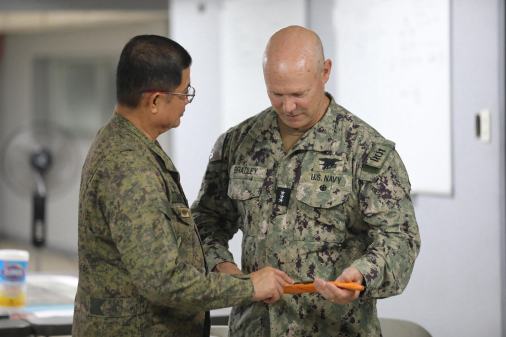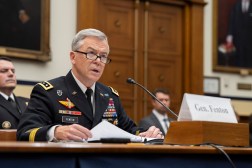Lawmakers fearful of SOCOM cuts, possible risk to mission

Members of Congress on both sides of the aisle expressed concern this week over cuts to special operations forces, with many vowing to plus-up their budget as a response.
During Senate and House subpanels, military leaders and members of Congress outlined force cuts and budget reductions that have led to risks in missions for special operations forces because, in many cases, the head of Special Operations Command has been forced to tell combatant commanders “no” when they request capabilities.
Headlining the details outlined on Capitol Hill in recent days is the fact that SOCOM has had a flat budget since 2019, leading to a 14% decrease in purchasing power and a 5,000-person reduction in forces across the command over the last three and a half years. That includes reducing roles in communications, logistics, intelligence, civil affairs and psychological operations, and specifically a reduction of 3,000 personnel for military information support operations.
“SOCOM has operated under stagnant budgets. The limitation of SOF end strength was a very short-sighted decision at a time when SOF capabilities are needed more than ever. We must change course now,” Sen. Joni Ernst, R-Iowa, the chair of the Senate Armed Services Subcommittee on Emerging Threats and Capabilities, said during a hearing Tuesday afternoon. “That is why I intend to work with the DOD to rebuild SOCOM’s budget. Given SOF’s critical role in national security, this is a wise and cost-effective investment.”
That view was shared among other members of the panel, as well as their counterparts in the House.
“I would like to plus them up … A big bump up in funding for the SOF community,” Rep. Morgan Luttrell, R-Texas, a retired Navy SEAL, told DefenseScoop in an interview Tuesday. “I know for a fact that they are hurting for funding lines, for pots of money in certain places, through discussions with the leadership. My stance is: Hey look, I’m going to work as hard as I can with the members in [House Armed Services Subcommittee on Intelligence and Special Operations] and with the committee to get you what you need, which we are having those discussions.”
A bump in funding for SOF will provide more placement and access for units forward-deployed, Luttrell said. Their global footprint and ability to flex at a moment’s notice provide a defensive posture that exceeds traditional measures, he said, whereas if conventional forces are required to show up, “we are in trouble.”
Sen. Elissa Slotkin, D-Mich., ranking member of the Subcommittee on Emerging Threats and Capabilities, noted that, like how Space Force was excluded from taking cuts, her hope was these high-demand mission sets would be taken into consideration as well.
“[I] just would hope that if there’s someone who’s picking and choosing missions that are going to be cut versus protected, I know you’re advocating, but that we realize that the units that are in highest demand should not be taking the same haircut as everybody else across the force,” she said.
Members of Congress led witnesses in talking about how the cuts to purchasing power and end strength have hurt special operations forces’ ability to meet the requirements of combatant commands, with SOCOM Commander Gen. Bryan Fenton explaining how it’s hurt his ability to offer support.
Combatant command requests are up 35 percent in the last three years due to the need for deterrence, Fenton said. Special operations forces bring a variety of capabilities in the way of building relationships, developing access, providing indications and warnings, closing kill webs or kill chains, and giving commanders options and opportunities they wouldn’t otherwise have in the hopes of preventing a drawn-out conflict.
“Where we’ve had to say, ‘no,’ I’ll give you a number: Last December in one of the global force management tanks, I had to say no 41 times to request[s],” Fenton told members of the House Armed Services Subcommittee on Intelligence and Special Operations on Wednesday. “It’s a high compliment that this SOF team is that value proposition to the entire department … [Why] we couldn’t do it, my sense, and I’ll wind this down for you, is two reasons: There’s certainly a capability and capacity piece against the great humans that do that work. And as you know, we’ve been reduced in the past couple years by up to 5,000. But there’s also now a fiscal constraint that’s pulling at us based on an increasingly decreasing top line that now comes into play.”
Others warned of the proposed eight percent cuts the Department of Defense is seeking across the board in a measure to reduce inefficiency and redundancy.
“I’m not a doctor, but if I was, it would be cutting into bone. We are already lean and efficient,” Colby Jenkins, the official performing the duties of the assistant secretary of defense for special operations and low-intensity conflict, said when asked by Rep. Jason Crow, D-Colo., what an eight percent cut would look like.
To that, Crow added: “There’s no fat in SOCOM. You’re lean and mean as you’re supposed to be.”
Jenkins replied that special forces leaders are doing their best to avoid the negative impacts of DOD-wide budget cuts at all costs.
Aside from deterrence, the cuts in personnel and resources have also hurt SOCOM’s ability to modernize, particularly as the character of war changes, slowing its ability to adopt new technologies such as uncrewed systems, artificial intelligence, additive manufacturing and autonomy.
Fenton described that due to a 14 percent reduction in buying power, which equates to about $1 billion, his command is unable to acquire capabilities that might be able to provide asymmetry on the battlefield.
To stress the importance of that, he used the backdrop of the conflict in Ukraine, where the Ukrainians have been outmatched in terms of legacy capabilities — tanks, missiles, airplanes and helicopters — against the Russians, but adopted asymmetric tools to impose costs on Russian forces and stay in the fight.
“From the modernization piece first, I think first and foremost, the risk is not winning, not being able to complete the mission in the future environment,” Fenton said. “We’re taking risks there, the inability to get after the things I think that are asymmetric, that are part of the changing character of war, to do it at speed. You could add anything uncrewed, artificial intelligence, additive manufacturing, autonomy, all that. I think we’re accruing high risk because we as SOCOM are not able to get after that based on a flat top line.”
Fenton noted that, additionally, the acquisition system needs significant modernization to keep up with these emerging technologies driving the changing character of warfare.
He called the current system “outdated” and “glacial,” designed for the old world of aircraft carriers and airplanes, but not suited for the modern battlefield.
“But what we’re seeing through the lens of Ukraine needs to be an acquisition and procurement system that is hyperspeed, supersonic. Because over there, we’re watching the changes in minutes, hours and days,” Fenton told members of the House.
He added that requirements must be addressed and updated by reducing the number of people involved in them to enable a faster cycle between operator, commander and acquisition, such as allowing those downrange to directly inform requirements.
The cycles could also be faster.
“As I think about the requirements process, certainly the buckets of time give us an opportunity to think through multi-year processes,” Fenton said. “Two years might see multi-year. I think to all of us, multi-year probably needs to be five-to-10 years so we can move at the speed and evolution of what we’re seeing out on the battlefield.”
Fenton also advocated for consolidating the “colors” of money and compressing multiple funding pots. Within the DOD, funds are divided into separate categories of operations and maintenance, procurement, and research and development, and they must be used only for those purposes, negating flexibility to move around additional allocated funds if needs require more in another pot.
“I think there’s a way to take a lot of that off, compress the multiple lines to just a couple and really modernize there,” Fenton said.






